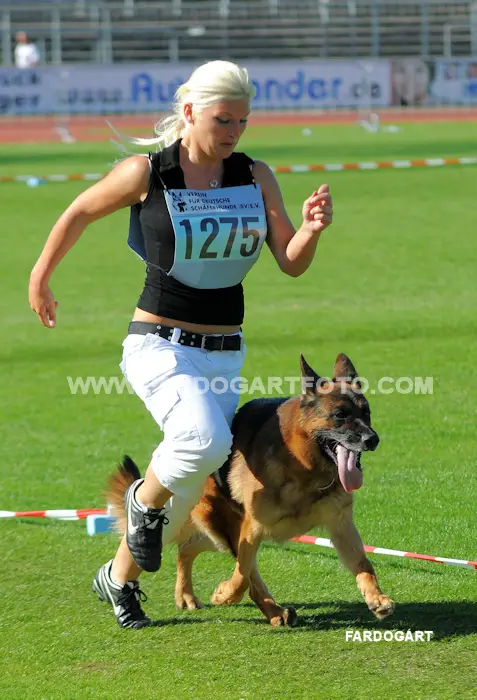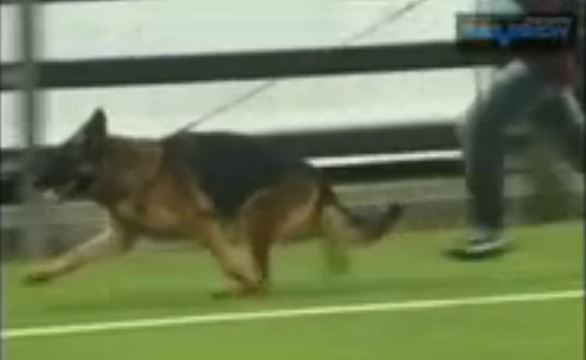
This is a placeholder text
Group text
by Blitzen on 05 September 2014 - 12:09
by Sunsilver on 05 September 2014 - 12:09
I always thought Vegas's movement sucked, but was never able to find a video to prove it. Now I have proof! He does not open up behind well at all, and sometimes the rear legs are galloping while his front is trotting! ![]()
As GSLs go, he does open up well in front, but it's obvious his upper arm is a bit short, which limits his reach. Due to his very long lower thigh, he tends to lift his front end and goose-step even when gaiting off leash...

by Blitzen on 05 September 2014 - 13:09
Djambo 4-4
Memphis 3-3
Kimbo 3-3
by Blitzen on 05 September 2014 - 13:09
Sometimes not watching the dog's feet and watching their backlines instead gives a better picture of how that dog is coordinated. An old AKC saying is - if you could sit a glass of water on it's shoulders and not a drop was spilled as the dog gaited, it's a good mover.
by Xeph on 05 September 2014 - 14:09
Vegas' foot timing was awful...
by Sunsilver on 06 September 2014 - 04:09
Managed to do a screen cap of Yankee, and his gaiting is definitely better than Vegas's:
Yankee
Vegas
I managed to stop the video at approximately the same point in the trot, then used the snipping tool to capture a still of the dog. Now, I know from my horesback riding days, the trot is a 2 beat gait, where diagonally opposite legs move in unison. Although this is still the case with the American showline dogs (see photo Blitzen posted above) the German dogs have redefined the gait. Vega's left hind is on the ground, while his right fore is still at least 3 inches in the air. While Yankee doesn't open up enough behind, at least his legs are moving more or less in unison, and his trot presents a much more harmonious picture than Vega's does.
I can't watch Vegas gait without cringing... ![]() Seriously, watch that slow motion video of him gaiting that's on the same YouTube page as Yankee!
Seriously, watch that slow motion video of him gaiting that's on the same YouTube page as Yankee!
by Sunsilver on 06 September 2014 - 04:09
Managed to do a screen cap of Yankee, and his gaiting is definitely better than Vegas's:
Yankee
Vegas
I managed to stop the video at approximately the same point in the trot, then used the snipping tool to capture a still of the dog. Now, I know from my horseback riding days that the trot is a 2 beat gait, where diagonally opposite legs move in unison. Although this is still the case with the American showline dogs (see photo Blitzen posted above of a very nice ASL gaiting!) the German dogs have redefined the gait. Vega's left hind is on the ground, while his right fore is still at least 3 inches in the air. While Yankee doesn't open up enough behind, at least his legs are moving more or less in unison, and his trot presents a much more harmonious picture than Vega's does.
I can't watch Vegas gait without cringing... ![]() Seriously, watch that slow motion video of him gaiting that's on the same YouTube page as Yankee!
Seriously, watch that slow motion video of him gaiting that's on the same YouTube page as Yankee!
Oh, and please notice, BOTH dogs have their hocks flat on the ground! Those of you who call the ASLs 'hockwalkers' please note! ![]()
by Blitzen on 06 September 2014 - 13:09
SS has offered more visual proof that GSL's are generally very restricted on both ends probably due to the physical limitations placed on them by their show world. The carp backs dont help much either. A dog can't be bred with ligaments that are too rigid and short to allow free movement and muscles that are "bunchy" ie not smooth and flexible. An ASL dog can have a ton of angulation fore and aft and as long as it has the long smooth flexible muscles and ligaments to compliment it, those dogs will always move smoother with a more outreaching and balanced gait. ASL's have as much or more angulation that any GSL I've ever seen in a photo and many of them move on ther hocks too - they have to - however the foot timing on the better ASL's is rarely off and they have more flexible joints and appear to be more athletic. Weight lifters vs runners.
I continue to be amazed at the videos owners and breeders post to the net showing what they consider to be correct movement.
by Ibrahim on 06 September 2014 - 15:09
It might be the fore chest development that restricts fore reach, I can not prove that but I have noticed ASL do not have the bulky fore chest that GSL have. Theoretically we know fore chest development is directly connected to correct shoulder angle, so it should make the front reach more but in actual life it does not.
i have noticed also that GSL has better shoulder blade lay than ASL, whether that plays a negative role in front reach beats me.
blitzen has always pressed on females being better trotters and I notice that no female has such a bulky fore chest like males do, but again I can not prove the negative role of bully fore chest in restricting fore reac, remains a thing to investigate
ibrahim
by Ibrahim on 06 September 2014 - 15:09
It is also worth mentioning that Dingo did not have the bulky fore chest development, his shoulder was closer to ASL than a GSL of today.
If I had to critique Dingo's shoulder it would be: very good length of front upper arm but Slightly steep, needs more lay of shoulder blade and needs more fore chest development.
Contact information Disclaimer Privacy Statement Copyright Information Terms of Service Cookie policy ↑ Back to top





.JPG)
